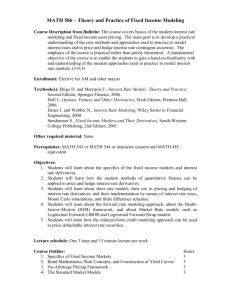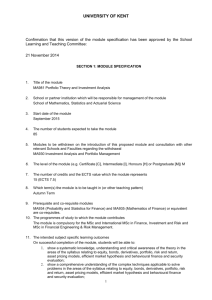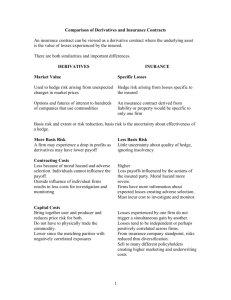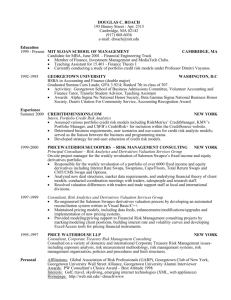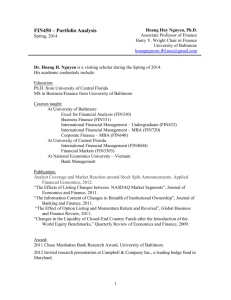Applications of MF
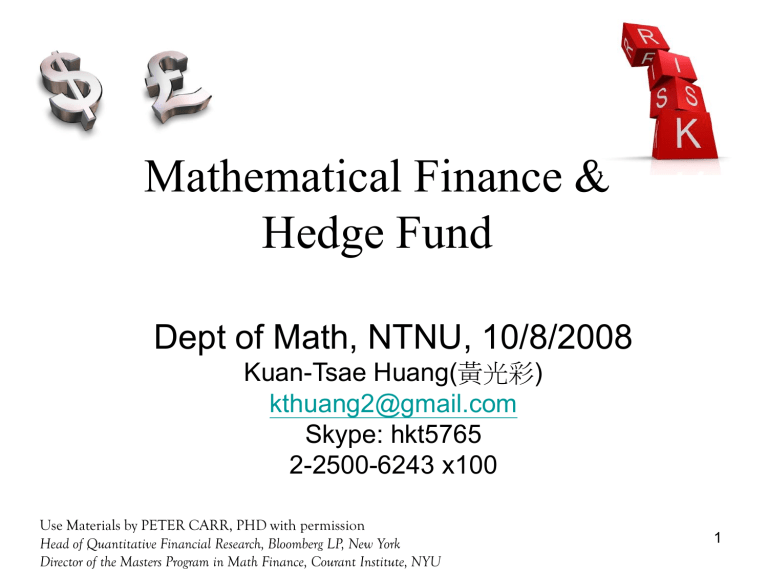
Mathematical Finance &
Hedge Fund
Dept of Math, NTNU, 10/8/2008
Kuan-Tsae Huang( 黃光彩 ) kthuang2@gmail.com
Skype: hkt5765
2-2500-6243 x100
Use Materials by PETER CARR, PHD with permission
Head of Quantitative Financial Research, Bloomberg LP, New York
Director of the Masters Program in Math Finance, Courant Institute, NYU
1
Hedge Fund ( 避險基金、對沖基金 )
• Alfred W. Jones created the first hedge fund in 1949
• Price movements of an individual asset = a component due to the overall market + a component due to the performance of the asset itself
• Balanced his portfolio by buying assets whose price he expected to rise and selling short assets he expected to fall.
• Price movements due to the overall market would be cancelled out because if the overall market rose the loss on shorted assets would be cancelled by the additional gain on assets bought and vice-versa. Because the effect is to
'hedge' that part of the risk due to overall market movements this became known as a hedge fund.
• Employ many different strategies, build from a number of different elements:
–
Style: global macro , directional, event driven , relative value ( arbitrage ), managed futures (CTA)
–
Market: equity , fixed income , commodity , currency
–
Instrument: long/short, futures , options
– Exposure: directional, market neutral
– Sector: emerging market , technology , healthcare etc.
– Method: discretionary/qualitative (where the individual investments are selected by managers), systematic/quantitative (or "quant" - where the investments are selected according to numerical methods using a computerized system)
–
Diversification: multi manager, multi strategy, multi fund, multi market
2
Source: http://en.wikipedia.org/wiki/Hedge_fund
金融市場的工具與衍生商品
• Cash( 現貨 ) :
– 直線的報償型態
– 作多為主
• Future( 期貨 ):
– 直線的報償型態
– 高槓桿操作
– 多空皆可獲利
• Option( 選擇權、期權 ):
– 曲線報償型態
– 高槓桿操作
– 多、空、盤整皆可獲利
– ETF (Exchange Traded
Fund): iShares, SPDR,
QQQ
– DR (Depository Receipt):
ADR, GDR, TDR
– CB/ECB (Convertibles)
– Swaps: Equity Swap, IRS,
Asset Swap,
Volatility/Variance
Swaps…
– CDO( 債務抵押債券 ) ,
CDS( 信用違約交換 )
3
財務工程-交易的三個層面
The creation of new and improved financial products with innovative design or repackaging of existing financial instruments through Combine( 組合 ) 、 Replicate( 複製 ) 、 Decompose ( 拆解 )
投機
(Speculation )
價值型
(Value)
Source: 寶來證券陳凌鶴
避險
(Hedging)
投資(Invest )
套利
(Arbitrage)
計量化投組管理
(Quantitative Asset
Management)
成長
(Growth)
4
How to Price This Option?
Assumption: (for simplicity)
• Interest rate r = 0
• One period binomial setting
Strategy: Creating an appropriate portfolio of stocks and bonds
Solution: Solve the linear equations
Value of the option at time t=0:
5
Asset Composition Strategy
In 2006, Global Financial Asset = 167 Trillions, Hedge Funds = 1.44 Trillions
6
Mathematical Finance History
Highlights
Bachelier (1900)
Kolmogorov/Levy/Doeblin/
Ito
Samuelson/Osborne
Black Scholes/Merton(70)
(Nobel 1997)
Cox Ross/Harrison Kreps/
Harrison Pliska (70-83)
HJM/BGM
Artzner Delbaen Heath
Eber (1999)
Li (2000)
Mathematicians Finance
• Marco Avellaneda
• Richard Beals
• Freddie Delbaen
• Nicole El Karoui (WSJ)
• Charles Fefferman
• Samuel Howison
• Joseph Keller
• Pierre Lyons
• Terry Lyons
• Paul Malliavin
• Benoit Mandelbrot
• Henry McKean
• George Papanicolau
• Chris Rogers
• Walter Schachermayer
• Albert Shiryaev
• Jim Simons
• Elias Stein
• Daniel Stroock
• Marc Yor
• Thaleia Zariphopoulou
• Samuelson
• Black and Scholes
• Robert C. Merton
• Cox and Ross
• Leland and Rubinstein
• Duffie and Singleton
• Brennan and Schwartz;
Longstaff and Schwartz
• Pliska, Jarrow, Madan
7
Mathematical Finance History
Making History Contributions
Bachelier (1900)
Kolmogorov/Levy/Doeblin/Ito
Samuelson/Osborne
Black Scholes/Merton(70)
(Nobel 1997)
Cox Ross/Harrison Kreps/
Harrison Pliska (70-83)
Theory of Speculation – The origins of modern finance
Brownian Motion (1950)
Are stock prices predictable?
Options pricing model
Stochastic calculus is now the language of pricing models and risk management
HJM/BGM
Brace-Gatarek-Musiela (BGM) model is an industry standard for pricing interest rate derivatives.
Heath-Jarrow-Morton (HJM) framework is to model the evolution of interest rates for risk management in general and asset liability management in particular
Artzner Delbaen Heath Eber
(1999)
David X. Li (2000)
Coherent measures of risk
One factor Gaussian copula model
– became the standard model used to quote CDO tranche prices 8
David Li’s Credit Derivatives
• Use of Gaussian copula models for the pricing of collateralized debt obligations.
• Model to weigh the likelihood that a given set of corporations would default on their bond debt in quick succession. Think of it as a produce scale that not only weighs a bag of apples but estimates the chance that they'll all be rotten in a week.
• In 1997, nobody knew how to calculate default correlations with any precision.
Mr. Li's solution drew inspiration from a concept in actuarial science known as the "broken heart": People tend to die faster after the death of a beloved spouse. Idea came from academia research on a way to predict death correlation, useful to companies that sell life insurance and joint annuities.
• "Default is like the death of a company, so we should model this the same way we model human life.“
• Actuarial science: Copulas help predict the likelihood of various events occurring when those events depend to some extent on one another.
• The model Mr. Li devised helped estimate what return investors in certain credit derivatives should demand, how much they have at risk and what strategies they should employ to minimize that risk. Big investors started using the model to make trades that entailed giant bets with little or none of their money tied up. Now, hundreds of billions of dollars ride on variations of the model every day
• Credit derivatives: investment vehicles that are based on corporate bonds and give their owners protection against a default. This is a market that barely existed in the mid-1990s. Now it is both so gigantic -measured in the trillions of dollars -- and so murky that it has drawn expressions of concern from several market watchers
9
Mathematics Used in
Mathematical Finance
• Stochastic Calculus: Markov
Processes, Itˆo’s Lemma,
Girsanov’s Thm
• Linear & Nonlinear PDE’s primarily 2nd order linear, esp. parabolic
• Monte Carlo Simulation
• Finite Differences, Finite
Elements, and Spectral Methods
• Functional Analysis - semi-groups
• Integral Transforms
Fourier/Gaussian/Hilbert/Laplace/
Radon
• Complex Analysis - for inverting transforms
• Pseudo Differential Operators
• Maximum Principle
• Fundamental Theorem of Linear
Algebra
• Hahn Banach Theorem
• Lie Groups
• Regular and Singular Perturbations
• Optimal Control
• Variational Inequalities
• Differential Geometry
• String Theory
• Game Theory
• Inverse Problems - Calibration
• Statistics, Econometrics, esp. time series.
10
Common Sense Used in Finance
• As Mark Twain once wrote, “common sense ain’t so common”.
• No practitioners that I know of think that derivatives are redundant. In fact, the closer someone is to the market, the less likely they are to value two ketchup bottles at twice the unit price.
• While the standard pricing models are linear, practitioners keenly appreciate the limited domain in which they operate:
– Reserves are set aside for model risk.
– Several models are used simultaneously, and the results are averaged.
– Fixed model parameters are routinely shocked; risks outside the model are routinely hedged.
• Nobody thinks quants are redundant (fortunately); much time is spent trying to find robust pricing and hedging strategies.
11
Masters Programs in MF
• To my knowledge, there are no undergrad programs solely devoted to math finance yet.
• The first Master’s program in MF was offered by CMU in
1992.
• There are now over 100 Master’s programs internationally.
• A typical Master’s program requires 1-1.5 years of fulltime attendance. Most programs in big cities also offer part-time.
• The programs are usually offered out of math or engineering dept.’s (or both); they are sometimes offered out of the B school as a standalone program (eg.
Haas) or as a track (eg. MIT).
• Graduates go to industry: NYU’s Courant graduates often go to the big banks or a hedge fund as trader’s assistants. Joining a quant group is fairly rare.
12
Doctoral Programs in Math,
Finance, and MF
• Doctoral programs almost never require a Master’s degree.
• It is common for doctoral students in math, engineering, computer science, or physics to get interested in MF at the thesis stage. They typically go into industry, primarily as quants in banks, hedge funds, ins. companies, and software companies.
• Some PhD’s go into academia, either as a post-doc (eg. at NYU) or less commonly, tenure-track eg. Chicago,
Columbia, Cambridge, Cornell, and others. They never go to B school.
• Most Finance PhD’s go to finance dept.’s in B school; a few go to industry.
• Some universities now offer PhD’s in MF (eg. CMU,
Imperial College).
13
MF Books for Mathematicians and Physicists
• Several books on MF have mathematicians as the target audience:
– Bjork – Arbitrage theory in continuous time
– Duffie – Dynamic asset pricing theory
– Jeanblanc, Yor, and Chesney – Mathematics methods for financial markets
– Musiela and Rutkowski, – Martingale methods in financial modelling
– Bielecki and Rutkowski – Credit risk
– Karatzas and Shreve, Shreve Vol II – Continuous-time models
– Shiryaev – Essentials of Stochastic Finance
• There are also books on MF and econo-physics aimed at physicists:
– Mantegna and Stanley – An Introduction to Econophysics
– Bouchaud and Potters – Theory of Financial Risk and Derivative
Pricing
– Ilinksi – Physics of Finance
14 http://finmath.com/
Conferences on Mathematical
Finance
• Bachelier Finance Congress, every 2 years - in London in 2008.
• The annual CCCP conference: Carnegie, Columbia,
Cornell, Princeton
• The annual Derivative Securities Conference: Queens,
Cornell, CFTC, Houston.
• The annual FORC conference in Warwick, UK.
• Numerous Practitioner Conferences from Risk, ICBI, and others. In particular, ICBI’s Global Derivatives
Conference in Paris is the equivalent of the academy awards.
• Bi-annual Journal of Investment Management (JOIM)
Conference in San Francisco in Spring 2007.
15
Academic Journals in MF
• Mathematical Finance
• Finance and Stochastics
• Quantitative Finance
• Journal of Computational Finance
• Review of Derivatives Research
• Applied Mathematical Finance
• International Journal of Theoretical and
Applied Finance
16
Applications of MF: The D Word
• Derivatives such as forwards, futures, and options have a long history (Thales).
• Derivatives trade either over-the-counter (eg. currency options) or on a listed exchange (eg. stock options) or both (eg. stock options).
• Derivatives have an underlying. The underlying can be an asset (eg. stock) or not (eg. stock index). Sometimes, the underlying can be stored (eg. wheat) or not, (eg. weather).
• The security underlying a derivative can have more liquidity than the derivative (eg. $/Euro) or less (eg. corporate bonds underlying credit default swaps. The underlying can be considered a primary asset eg. a bond underlying a bond option) or it can be a derivative itself
(eg. swaptions, options on VIX).
17
Are Derivatives Evil?
• After a week of North Korea’s nuclear test, the South
Korean military had proposed opening a market in synthetic CDO’s, heeding billionaire investor Warren
Buffet’s characterization of derivatives as weapons of mass destruction.
• In 2006, former Enron CEO Jeff Skilling was found guilty of fraud. Skilling was sentenced to 24 years in prison.
Once the 7th largest corporation in America, Enron had championed the notion of electricity derivatives, and was blamed for the rolling blackouts that roiled California.
When asked how many years Skilling should face, most
Californians called for a revival of the electric chair.
• In 1994, Orange County famously lost huge sums of money betting incorrectly that interest rates would not rise. The subsequent tax increase forced Disneyland to raise admission fees.
18
And You Think Car Insurance is Bad
• By October 1987, approximately 100 billion dollars of equities were covered by “portfolio insurance”, a novel financial strategy which attempts to place a floor on the value of a stock portfolio by attempting to replicate the payoff of a put. The leading provider of this form of portfolio insurance was LOR (Leland, O'Brien, and Rubinstein), which was started by two Berkeley professors. On page 19 of LOR’s standard contract, a footnote mentioned that this form of portfolio insurance doesn’t work in a crash.
• In the wake of the Oct. 87 crash, the Brady commission blamed portfolio insurers for mechanically selling stock index futures on Black Monday, as called for by their nonanticipating strategy. In fact, LOR famously undersold futures relative to this strategy, which itself undersells when a crash is anticipated. As a result, many LOR clients had their floors violated, discrediting portfolio insurance for several years.
19 http://money.cnn.com/magazines/fortune/fortune_archive/1988/01/04/70047/index.htm
Applications of MF: Risk
Measurement and Management
• Banks are exposed to market risk , the possibility that losses will arise due to adverse marking of its assets and liabilities. As a result, banks are required to calculate a risk measure known as Value at Risk on a daily basis.
• Widely criticized for its properties, the wide use of VaR has lead to much academic and industrial research in alternative risk measures.
• In the wake of corporate scandals such as Worldcom and Enron, the Sarbanes Oxley act of 2002 forced
CEO’s to sign off on the accuracy of their firm’s financial statements. As intended, this has lead to a renewed emphasis on the risk management function inside many corporations.
• Continuing banking reforms from Basel have also lead to research in other forms of risk, such as counterparty credit risk & operational risk.
20
Applications of MF:
ALM
• Pension plans have long term “fixed” liabilities whose magnitude is based on actuarial estimates of retirement age, future salaries, mortality rates, etc.
• Similarly, insurance companies promise fixed annuity payments whose length extends from the beneficiary’s retirement until death.
• In both cases, it is common practice to invest some fraction of the company’s assets in equities to partake of their higher average growth over the long term. This leads to Asset and Liability Management (ALM), a field which has long used quantitative methods, but is just beginning to succumb to market-oriented quantitative techniques.
21
Applications of MF:
Variable Annuities
• To mitigate their market risk, insurance companies offer variable annuities , i.e. life insurance policies whose payoff is positively linked to the performance of equity markets.
• Unfortunately, long term path-dependent guarantees (eg. in GMDB’s) embedded in the policies lead to large losses during the last bear market.
• As a result, most large insurers now delta hedge their equity exposures.
22
Applications of MF:
Algorithmic Trading
• If market prices are martingales, then one can neither gain nor lose on average from non-anticipating trading strategies.
• However sometimes you can partially anticipate market movements, eg. NAV’s of mutual funds with cross country positions.
• Finance academics used to believe that markets are too efficient in order to systematically profit from predictable market movements. The rise in CPU power lead many academics to abandon that view and start hedge funds to exploit “anomalies”.
• Simultaneous advances in automated trading and in the theory of market micro-structure have lead to the formation of companies such as Automated Trading
Desk (ATD) which place orders hundreds of times per second.
23
Applications of MF:
Portfolio Insurance Again
• A different form of portfolio insurance called Constant
Proportion Portfolio Insurance (CPPI) is presently in wide use. While similar to portfolio insurance based on synthetic put replication employed in the 80’s, the CPPI trading strategy differs in several important ways:
1. Insurance is provided contractually rather than on a best efforts basis (insurer is principal, not agent).
2. Insurance is usually only provided on diversified portfolios, such as funds of hedge funds, or pools of CDO’s.
3.
CPPI does not require knowing the underlying asset’s volatility.
• Fischer Black invented (68) and popularized (87) CPPI with e = mc(sqaure) .
• Banks also provide options on CPPI.
24
Active Research Areas in
Mathematical Finance
• Stochastic Volatility and L´evy Processes
(see my website for eg.)
• Market Models (eg. BGM and market models of implied vol)
• Default Risk and Credit Derivatives (see www.defaultrisk.com)
• Liquidity (also hot in academic finance)
• Hedge Funds and Algorithmic Trading
• Inverse Problems/Calibration Issues
25
Open Problems in
Mathematical Finance
• Simple Closed Form Formula for American
Put in Black Scholes
• Forward PDE for American Options in
Local Volatility model
• Fast Accurate Pricing of Synthetic CDO tranches
• Pricing in Incomplete Markets
26
The U.S. Life Insurance Market
• Primary Market for U.S.-Life
Insurance:
– > USD 16 trillion
– = 7 x larger than the
German Life Insurance
Market
• 63 % of all Americans hold Life
Insurance Policies
• Secondary Market in 2002: USD 2 billion*
• Growth : ca. 20%*
• Estimated Potential Market : USD
250 – 500 billion*
• Estimated 2007 Market: USD 10 -
12 billion
• Estimated 2008 Market: USD 16 -
20 billion (forecast)
Significant growth in the life settlement market (US)
27
Sources*: Conning Research & Consulting, Inc., 2005 Bernstein Research Report
Summary and Conclusions
• Continuing demand from industry for quantitatively-oriented students bodes well for
Masters and PhD level programs in MF.
• This demand stems from several sources:
1. ready availability of data (eg. Bloomberg) and computing power
2. legal reforms (eg. Sarbanes Oxley, Basel II)
3. the rise (and occasional fall) of hedge funds employing sophisticated and unencumbered trading strategies.
4. softening of MBA programs?
• Algorithmic Trading (>50%) + Statistical Arbitrage
• MF should benefit considerably from the R&D by
NTNU’s considerable quantitative talents.
28
29
FOR MORE INFORMATION, PLEASE CONTACT:
• Kuan-Tsae Huang
• kthuang2@gmail.com
• Skype: hkt5765
• 2-2500-6243 x100
30
